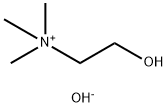POPC
Synonym(s):PC;POPC;PC(16:0/18:1);PC(16:0/18:1w9);PC(16:0/18:1(9Z))
- CAS NO.:26853-31-6
- Empirical Formula: C42H82NO8P
- Molecular Weight: 760.08
- MDL number: MFCD00077387
- EINECS: 248-056-7
- SAFETY DATA SHEET (SDS)
- Update Date: 2024-11-19 23:02:33

What is POPC?
Description
1-
Description
1-Palmitoyl-2-oleoyl-sn-glycero-3-phosphocholine (POPhtCho), is a phosphatidylcholine, that belongs to a class of phospholipids that are a major component of biological membranes. This compound has been shown to decrease the expression of α-amino-3-hydroxy-5-methyl-4-isoxazole propionic acid (AMPA) receptor subunit GluR1 on the plasma membrane of CA1 region of rat hippocampal slices.
The Uses of POPC
The effect of non-ionic detergent on liposomes was studied with giant POPC liposomes. Increasing concentrations of detergent cause tubular protrusions, then indentations, to develop on spherical liposomes. At higher detergent concentrations, the liposomes burst.
The Uses of POPC
Glycerophospholipids act as regulators of various enzyme activities, and can be used as biological markers to indicate pathological states.
The Uses of POPC
16:0-18:1 PC has been used in the preparation of liposomes for the muramyl tripeptide encapsulation. It has also been used in the preparation of membrane scaffold protein 1 nanodisc. 16:0-18:1 PC may be used in the synthesis of discoidal reconstituted high-density lipoproteins.
What are the applications of Application
1-Palmitoyl-2-oleoyl-sn-glycero-3-phosphocholine is a phosphatidylcholine
What are the applications of Application
POPC is an important phospholipid for biophysical experiments and has been used to study various subjects such as lipid rafts. POPC is also used in systems mimicking the cell membrane such as Nanodiscs. It is available commercially synthetically and is naturally present in eukaryotic cell membranes.
Definition
ChEBI: 1-hexadecanoyl-2-(9Z-octadecenoyl)-sn-glycero-3-phosphocholine is a phosphatidylcholine 34:1 in which the 1- and 2-acyl groups are specified as hexadecanoyl (palmitoyl) and 9Z-octadecenoyl (oleoyl) respectively. It has a role as a mouse metabolite. It is a phosphatidylcholine 34:1 and a 1-acyl-2-oleoyl-sn-glycero-3-phosphocholine betaine. It is functionally related to a hexadecanoic acid and an oleic acid.
General Description
POPC is typically considered one of the model lipids for biophysical experiments. The fatty acid composition, i.e., saturated chain in the sn-1 position and unsaturated chain in the sn-2 position, mimics mammalian phospholipid composition. Since the major constituent in Egg PC is 1-palmitoyl-2-oleoyl PC, POPC is an excellent synthetic substitute for EPC.
Biochem/physiol Actions
1-palmitoyl-2-oleoyl-glycero-3-phosphocholine (POPC)or 16:0-18:1 PC plays an important role as a lung surfactant and reduces surface tension. POPC mimics natural cell membrane and may be useful for unsaturated lipids oxidation studies. Its interaction with ozone leads to oxidative decomposition at the oleoyl strand C-C moiety.
Properties of POPC
| Melting point: | -3 °C |
| storage temp. | -20°C |
| solubility | Ethanol: 25mg/ml |
| form | A crystalline solid |
| color | White to off-white |
| BRN | 4173237 |
Safety information for POPC
| Signal word | Danger |
| Pictogram(s) |
 Skull and Crossbones Acute Toxicity GHS06  Health Hazard GHS08 |
| GHS Hazard Statements |
H302:Acute toxicity,oral H315:Skin corrosion/irritation H319:Serious eye damage/eye irritation H331:Acute toxicity,inhalation H336:Specific target organ toxicity,single exposure; Narcotic effects H351:Carcinogenicity H372:Specific target organ toxicity, repeated exposure H412:Hazardous to the aquatic environment, long-term hazard |
| Precautionary Statement Codes |
P201:Obtain special instructions before use. P273:Avoid release to the environment. P302+P352:IF ON SKIN: wash with plenty of soap and water. P308+P313:IF exposed or concerned: Get medical advice/attention. |
Computed Descriptors for POPC
New Products
(S)-3-Aminobutanenitrile hydrochloride 4-Methylphenylacetic acid N-Boc-D-alaninol N-BOC-D/L-ALANINOL Tert-butyl bis(2-chloroethyl)carbamate 3-Morpholino-1-(4-nitrophenyl)-5,6-dihydropyridin- 2(1H)-one Furan-2,5-Dicarboxylic Acid Tropic acid 1-Bromo-3,5-Di-Tert-Butylbenzene S-2-CHLORO PROPIONIC ACID ETHYL ISOCYANOACETATE 2-Bromo-1,3-Bis(Dimethylamino)Trimethinium Hexafluorophosphate 4-IODO BENZOIC ACID 3-NITRO-2-METHYL ANILINE 1-(2,4-DICHLOROPHENYL) ETHANAMINE (2-Hydroxyphenyl)acetonitrile 4-Bromopyrazole 2-(Cyanocyclohexyl)acetic acid 4-methoxy-3,5-dinitropyridine 1-(4-(aminomethyl)benzyl)urea hydrochloride 2-aminopropyl benzoate hydrochloride diethyl 2-(2-((tertbutoxycarbonyl)amino) ethyl)malonate tert-butyl 4- (ureidomethyl)benzylcarbamate Ethyl-2-chloro((4-methoxyphenyl)hydrazono)acetateRelated products of tetrahydrofuran








You may like
-
 2-Oleoyl-1-palmitoyl-sn-glycero-3-phosphocholine CAS 26853-31-6View Details
2-Oleoyl-1-palmitoyl-sn-glycero-3-phosphocholine CAS 26853-31-6View Details
26853-31-6 -
 2-Oleoyl-1-palmitoyl-sn-glycero-3-phosphocholine CAS 26853-31-6View Details
2-Oleoyl-1-palmitoyl-sn-glycero-3-phosphocholine CAS 26853-31-6View Details
26853-31-6 -
 16:0-18:1 PC CAS 26853-31-6View Details
16:0-18:1 PC CAS 26853-31-6View Details
26853-31-6 -
 16:0-18:1(n9) PC - IsoPure CAS 26853-31-6View Details
16:0-18:1(n9) PC - IsoPure CAS 26853-31-6View Details
26853-31-6 -
 1975-50-4 98%View Details
1975-50-4 98%View Details
1975-50-4 -
 2-HYDROXY BENZYL ALCOHOL 98%View Details
2-HYDROXY BENZYL ALCOHOL 98%View Details
90-01-7 -
 14714-50-2 (2-Hydroxyphenyl)acetonitrile 98+View Details
14714-50-2 (2-Hydroxyphenyl)acetonitrile 98+View Details
14714-50-2 -
 118753-70-1 98+View Details
118753-70-1 98+View Details
118753-70-1